steering SKODA ROOMSTER 2006 1.G Owner's Guide
[x] Cancel search | Manufacturer: SKODA, Model Year: 2006, Model line: ROOMSTER, Model: SKODA ROOMSTER 2006 1.GPages: 274, PDF Size: 48.64 MB
Page 184 of 274
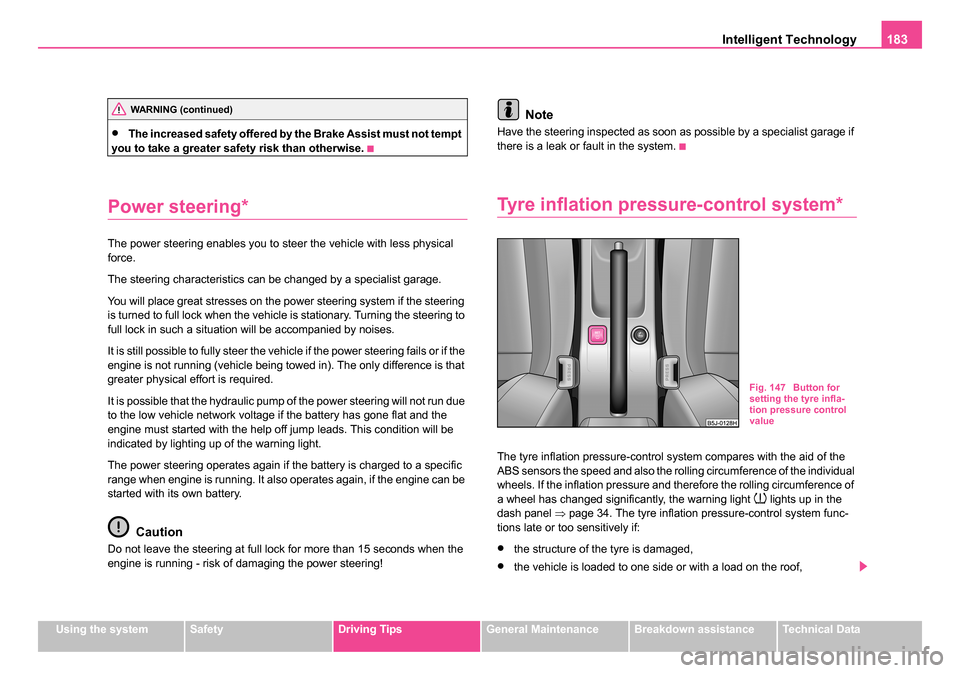
Intelligent Technology183
Using the systemSafetyDriving TipsGeneral MaintenanceBreakdown assistanceTechnical Data
•The increased safety offered by the Brake Assist must not tempt
you to take a greater safety risk than otherwise.
Power steering*
The power steering enables you to steer the vehicle with less physical
force.
The steering characteristics can be changed by a specialist garage.
You will place great stresses on the power steering system if the steering
is turned to full lock when the vehicle is stationary. Turning the steering to
full lock in such a situation will be accompanied by noises.
It is still possible to fully steer the vehicle if the power steering fails or if the
engine is not running (vehicle being towed in). The only difference is that
greater physical effort is required.
It is possible that the hydraulic pump of the power steering will not run due
to the low vehicle network voltage if the battery has gone flat and the
engine must started with the help off jump leads. This condition will be
indicated by lighting up of the warning light.
The power steering operates again if the battery is charged to a specific
range when engine is running. It also operates again, if the engine can be
started with its own battery.
Caution
Do not leave the steering at full lock for more than 15 seconds when the
engine is running - risk of damaging the power steering!
Note
Have the steering inspected as soon as possible by a specialist garage if
there is a leak or fault in the system.
Tyre inflation pressure-control system*
The tyre inflation pressure-control system compares with the aid of the
ABS sensors the speed and also the roll ing circumference of the individual
wheels. If the inflation pressure and therefore the rolling circumference of
a wheel has changed significantly, the warning light
lights up in the
dash panel ⇒page 34. The tyre inflation pressure-control system func-
tions late or too sensitively if:
•the structure of the tyre is damaged,
•the vehicle is loaded to one side or with a load on the roof,
WARNING (continued)
Fig. 147 Button for
setting the tyre infla-
tion pressure control
value
NKO 20 A05.book Page 183 Wednesday, June 21, 2006 1:42 PM
Page 185 of 274
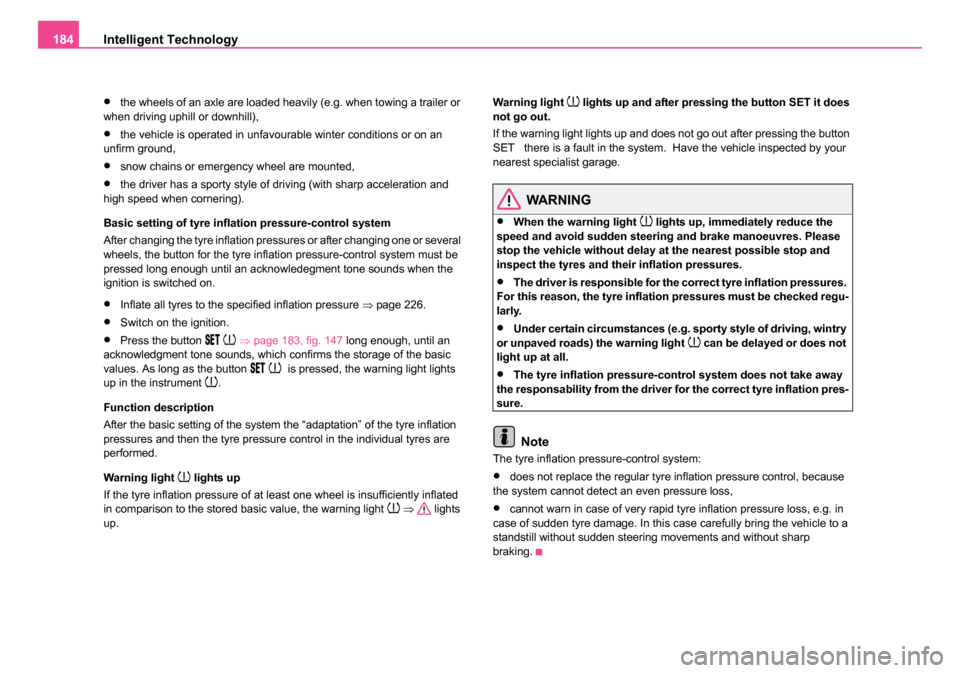
Intelligent Technology
184
•the wheels of an axle are loaded heavily (e.g. when towing a trailer or
when driving uphill or downhill),
•the vehicle is operated in unfavourable winter conditions or on an
unfirm ground,
•snow chains or emergency wheel are mounted,
•the driver has a sporty style of driving (with sharp acceleration and
high speed when cornering).
Basic setting of tyre inflation pressure-control system
After changing the tyre inflation pressures or after changing one or several
wheels, the button for the tyre inflation pressure-control system must be
pressed long enough until an acknowledegment tone sounds when the
ignition is switched on.
•Inflate all tyres to the specified inflation pressure ⇒page 226.
•Switch on the ignition.
•Press the button ⇒ page 183, fig. 147 long enough, until an
acknowledgment tone sounds, which confirms the storage of the basic
values. As long as the button
is pressed, the warning light lights
up in the instrument .
Function description
After the basic setting of the system the “adaptation” of the tyre inflation
pressures and then the tyre pressure control in the individual tyres are
performed.
Warning light
lights up
If the tyre inflation pressure of at least one wheel is insufficiently inflated
in comparison to the stored basic value, the warning light
⇒ lights
up. Warning light
lights up and after pressing the button SET it does
not go out.
If the warning light lights up and does not go out after pressing the button
SET there is a fault in the system. Have the vehicle inspected by your
nearest specialist garage.
WARNING
•When the warning light lights up, immediately reduce the
speed and avoid sudden steering and brake manoeuvres. Please
stop the vehicle without delay at the nearest possible stop and
inspect the tyres and their inflation pressures.
•The driver is responsible for the correct tyre inflation pressures.
For this reason, the tyre inflation pressures must be checked regu-
larly.
•Under certain circumstances (e.g. sporty style of driving, wintry
or unpaved roads) the warning light can be delayed or does not
light up at all.
•The tyre inflation pressure-control system does not take away
the responsability from the driver for the correct tyre inflation pres-
sure.
Note
The tyre inflation pressure-control system:
•does not replace the regular tyre inflation pressure control, because
the system cannot detect an even pressure loss,
•cannot warn in case of very rapid tyre inflation pressure loss, e.g. in
case of sudden tyre damage. In this case carefully bring the vehicle to a
standstill without sudden steering movements and without sharp
braking.
NKO 20 A05.book Page 184 Wednesday, June 21, 2006 1:42 PM
Page 202 of 274
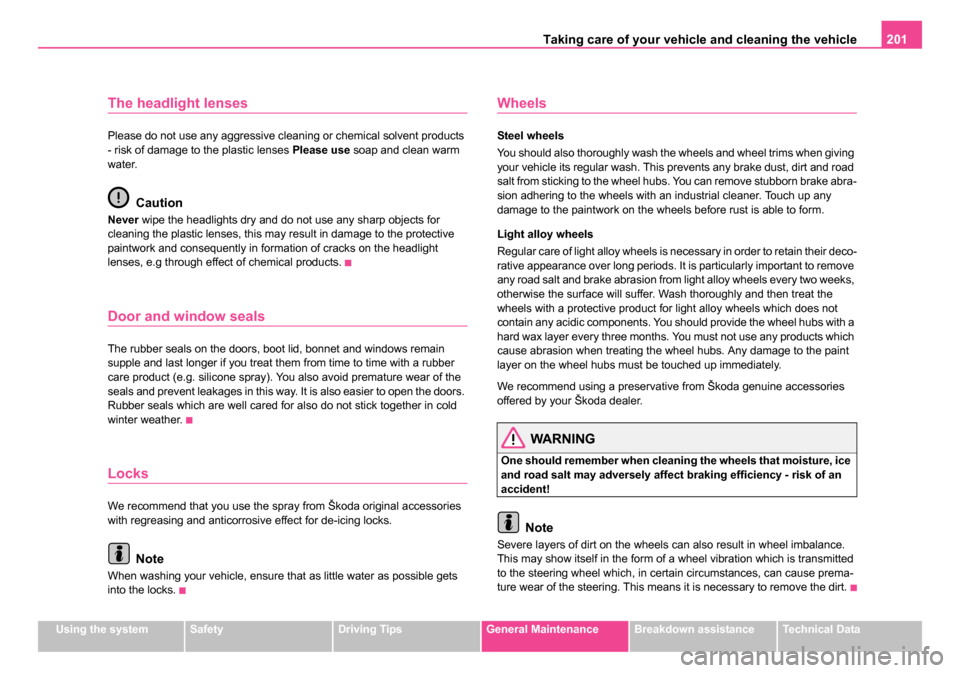
Taking care of your vehicle and cleaning the vehicle 201
Using the systemSafetyDriving TipsGeneral MaintenanceBreakdown assistanceTechnical Data
The headlight lenses
Please do not use any aggressive cleaning or chemical solvent products
- risk of damage to the plastic lenses Please use soap and clean warm
water.
Caution
Never wipe the headlights dry and do not use any sharp objects for
cleaning the plastic lenses, this may result in damage to the protective
paintwork and consequently in formation of cracks on the headlight
lenses, e.g through effect of chemical products.
Door and window seals
The rubber seals on the doors, boot lid, bonnet and windows remain
supple and last longer if you treat them from time to time with a rubber
care product (e.g. silicone spray). You also avoid premature wear of the
seals and prevent leakages in this way. It is also easier to open the doors.
Rubber seals which are well cared for also do not stick together in cold
winter weather.
Locks
We recommend that you use the spray from Škoda original accessories
with regreasing and anticorrosive effect for de-icing locks.
Note
When washing your vehicle, ensure that as little water as possible gets
into the locks.
Wheels
Steel wheels
You should also thoroughly wash the wheels and wheel trims when giving
your vehicle its regular wash. This prevents any brake dust, dirt and road
salt from sticking to the wheel hubs. You can remove stubborn brake abra-
sion adhering to the wheels with an industrial cleaner. Touch up any
damage to the paintwork on the wheels before rust is able to form.
Light alloy wheels
Regular care of light alloy wheels is necessary in order to retain their deco-
rative appearance over long periods. It is particularly important to remove
any road salt and brake abrasion from light alloy wheels every two weeks,
otherwise the surface will suffer. Wash thoroughly and then treat the
wheels with a protective product for light alloy wheels which does not
contain any acidic components. You should provide the wheel hubs with a
hard wax layer every three months. You must not use any products which
cause abrasion when treating the wheel hubs. Any damage to the paint
layer on the wheel hubs must be touched up immediately.
We recommend using a preservative from Škoda genuine accessories
offered by your Škoda dealer.
WARNING
One should remember when cleaning the wheels that moisture, ice
and road salt may adversely affect braking efficiency - risk of an
accident!
Note
Severe layers of dirt on the wheels can also result in wheel imbalance.
This may show itself in the form of a wheel vibration which is transmitted
to the steering wheel which, in certain circumstances, can cause prema-
ture wear of the steering. This means it is necessary to remove the dirt.
NKO 20 A05.book Page 201 Wednesday, June 21, 2006 1:42 PM
Page 219 of 274
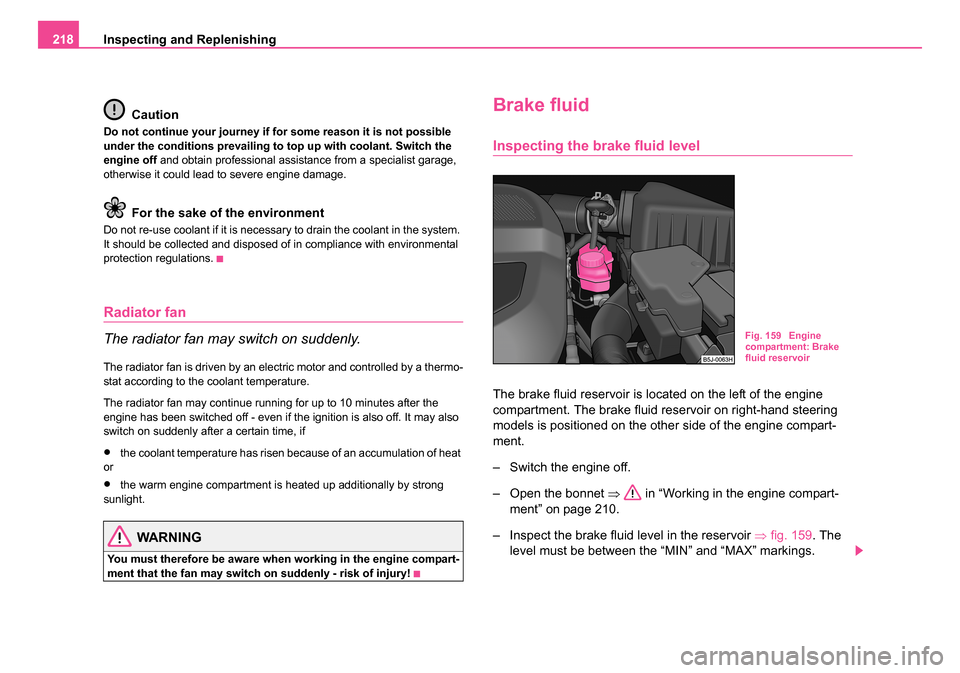
Inspecting and Replenishing
218
Caution
Do not continue your journey if for some reason it is not possible
under the conditions prevailing to top up with coolant. Switch the
engine off and obtain professional assistance from a specialist garage,
otherwise it could lead to severe engine damage.
For the sake of the environment
Do not re-use coolant if it is necessary to drain the coolant in the system.
It should be collected and disposed of in compliance with environmental
protection regulations.
Radiator fan
The radiator fan may switch on suddenly.
The radiator fan is driven by an electric motor and controlled by a thermo-
stat according to the coolant temperature.
The radiator fan may continue running for up to 10 minutes after the
engine has been switched off - even if the ignition is also off. It may also
switch on suddenly after a certain time, if
•the coolant temperature has risen because of an accumulation of heat
or
•the warm engine compartment is heated up additionally by strong
sunlight.
WARNING
You must therefore be aware when working in the engine compart-
ment that the fan may switch on suddenly - risk of injury!
Brake fluid
Inspecting the brake fluid level
The brake fluid reservoir is located on the left of the engine
compartment. The brake fluid reservoir on right-hand steering
models is positioned on the other side of the engine compart-
ment.
– Switch the engine off.
– Open the bonnet ⇒ in “Working in the engine compart-
ment” on page 210.
– Inspect the brake fluid level in the reservoir ⇒fig. 159 . The
level must be between the “MIN” and “MAX” markings.
Fig. 159 Engine
compartment: Brake
fluid reservoir
NKO 20 A05.book Page 218 Wednesday, June 21, 2006 1:42 PM
Page 227 of 274
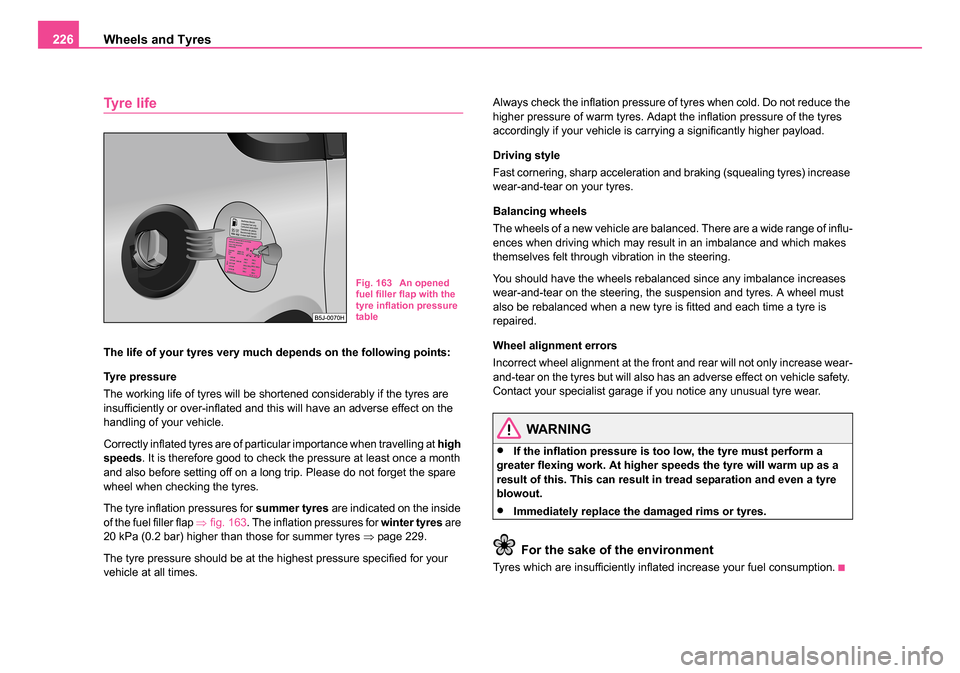
Wheels and Tyres
226
Tyre life
The life of your tyres very much depends on the following points:
Tyre pressure
The working life of tyres will be shortened considerably if the tyres are
insufficiently or over-inflated and this will have an adverse effect on the
handling of your vehicle.
Correctly inflated tyres are of particular importance when travelling at high
speeds . It is therefore good to check the pressure at least once a month
and also before setting off on a long trip. Please do not forget the spare
wheel when checking the tyres.
The tyre inflation pressures for summer tyres are indicated on the inside
of the fuel filler flap ⇒fig. 163 . The inflation pressures for winter tyres are
20 kPa (0.2 bar) higher than those for summer tyres ⇒page 229.
The tyre pressure should be at the highest pressure specified for your
vehicle at all times. Always check the inflation pressure of tyres when cold. Do not reduce the
higher pressure of warm tyres. Adapt the inflation pressure of the tyres
accordingly if your vehicle is carrying a significantly higher payload.
Driving style
Fast cornering, sharp acceleration and braking (squealing tyres) increase
wear-and-tear on your tyres.
Balancing wheels
The wheels of a new vehicle are balanced. There are a wide range of influ-
ences when driving which may result in an imbalance and which makes
themselves felt through vibration in the steering.
You should have the wheels rebalanced since any imbalance increases
wear-and-tear on the steering, the suspension and tyres. A wheel must
also be rebalanced when a new tyre is fitted and each time a tyre is
repaired.
Wheel alignment errors
Incorrect wheel alignment at the front and rear will not only increase wear-
and-tear on the tyres but will also has an adverse effect on vehicle safety.
Contact your specialist garage if you notice any unusual tyre wear.
WARNING
•If the inflation pressu
re is too low, the tyre must perform a
greater flexing work. At higher sp eeds the tyre will warm up as a
result of this. This can result in tread separation and even a tyre
blowout.
•Immediately replace the damaged rims or tyres.
For the sake of the environment
Tyres which are insufficiently inflated increase your fuel consumption.
Fig. 163 An opened
fuel filler flap with the
tyre inflation pressure
table
NKO 20 A05.book Page 226 Wednesday, June 21, 2006 1:42 PM
Page 246 of 274
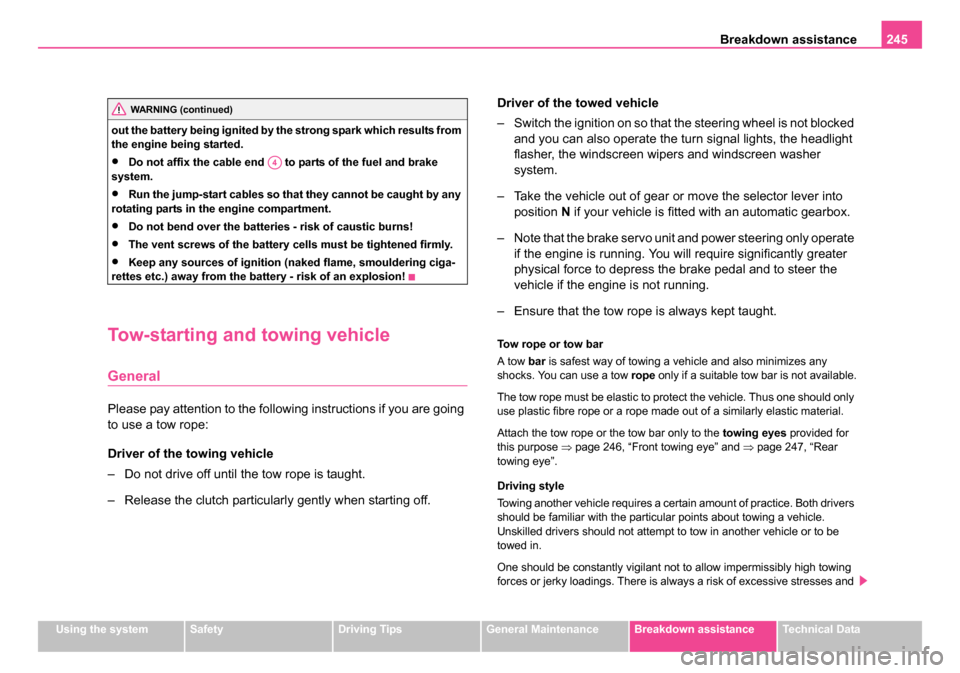
Breakdown assistance245
Using the systemSafetyDriving TipsGeneral MaintenanceBreakdown assistanceTechnical Data
out the battery being ignited by the strong spark which results from
the engine being started.
•Do not affix the cable end to parts of the fuel and brake
system.
•Run the jump-start cables so that they cannot be caught by any
rotating parts in the engine compartment.
•Do not bend over the batteries - risk of caustic burns!
•The vent screws of the battery cells must be tightened firmly.
•Keep any sources of ignition (naked flame, smouldering ciga-
rettes etc.) away from the battery - risk of an explosion!
Tow-starting and towing vehicle
General
Please pay attention to the following instructions if you are going
to use a tow rope:
Driver of the towing vehicle
– Do not drive off until the tow rope is taught.
– Release the clutch particularly gently when starting off. Driver of the towed vehicle
– Switch the ignition on so that the steering wheel is not blocked
and you can also operate the turn signal lights, the headlight
flasher, the windscreen wipers and windscreen washer
system.
– Take the vehicle out of gear or move the selector lever into position N if your vehicle is fitted with an automatic gearbox.
– Note that the brake servo unit and power steering only operate if the engine is running. You will require significantly greater
physical force to depress the brake pedal and to steer the
vehicle if the engine is not running.
– Ensure that the tow rope is always kept taught.
Tow rope or tow bar
A tow bar is safest way of towing a vehicle and also minimizes any
shocks. You can use a tow rope only if a suitable tow bar is not available.
The tow rope must be elastic to protect the vehicle. Thus one should only
use plastic fibre rope or a rope made out of a similarly elastic material.
Attach the tow rope or the tow bar only to the towing eyes provided for
this purpose ⇒page 246, “Front towing eye” and ⇒page 247, “Rear
towing eye”.
Driving style
Towing another vehicle requires a certain amount of practice. Both drivers
should be familiar with the particular points about towing a vehicle.
Unskilled drivers should not attempt to tow in another vehicle or to be
towed in.
One should be constantly vigilant not to allow impermissibly high towing
forces or jerky loadings. There is always a risk of excessive stresses and
WARNING (continued)
A4
NKO 20 A05.book Page 245 Wednesday, June 21, 2006 1:42 PM
Page 251 of 274
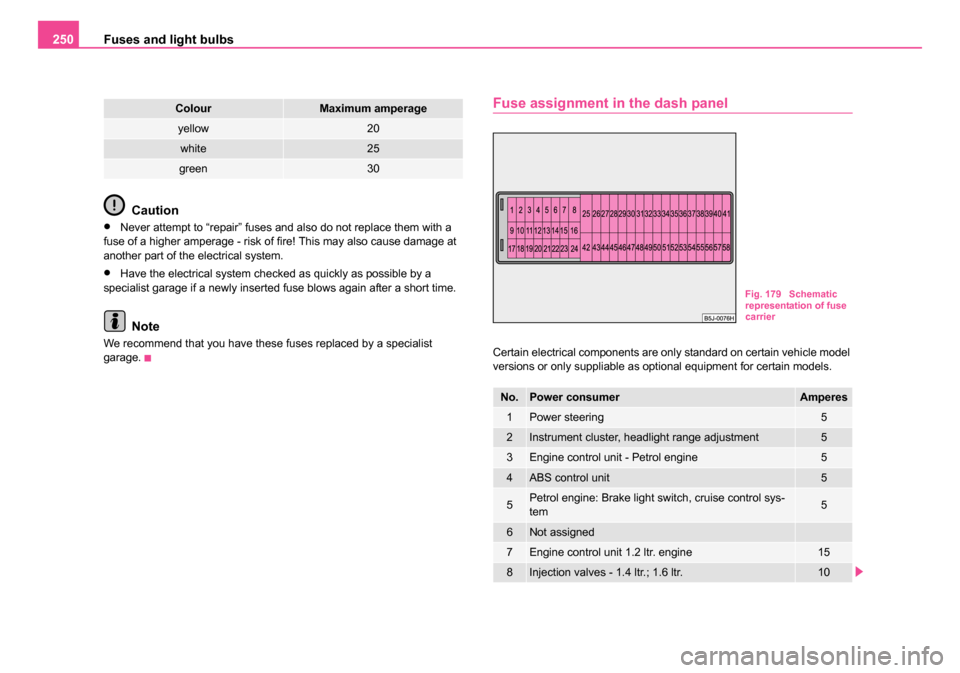
Fuses and light bulbs
250
Caution
•Never attempt to “repair” fuses and also do not replace them with a
fuse of a higher amperage - risk of fire! This may also cause damage at
another part of the electrical system.
•Have the electrical system checked as quickly as possible by a
specialist garage if a newly inserted fuse blows again after a short time.
Note
We recommend that you have these fuses replaced by a specialist
garage.
Fuse assignment in the dash panel
Certain electrical components are only standard on certain vehicle model
versions or only suppliable as optional equipment for certain models.
yellow20
white25
green30
ColourMaximum amperage
No.Power consumerAmperes
1Power steering5
2Instrument cluster, headlight range adjustment5
3Engine control unit - Petrol engine5
4ABS control unit5
5Petrol engine: Brake light switch, cruise control sys-
tem5
6Not assigned
7Engine control unit 1.2 ltr. engine15
8Injection valves - 1.4 ltr.; 1.6 ltr.10
Fig. 179 Schematic
representation of fuse
carrier
NKO 20 A05.book Page 250 Wednesday, June 21, 2006 1:42 PM
Page 252 of 274
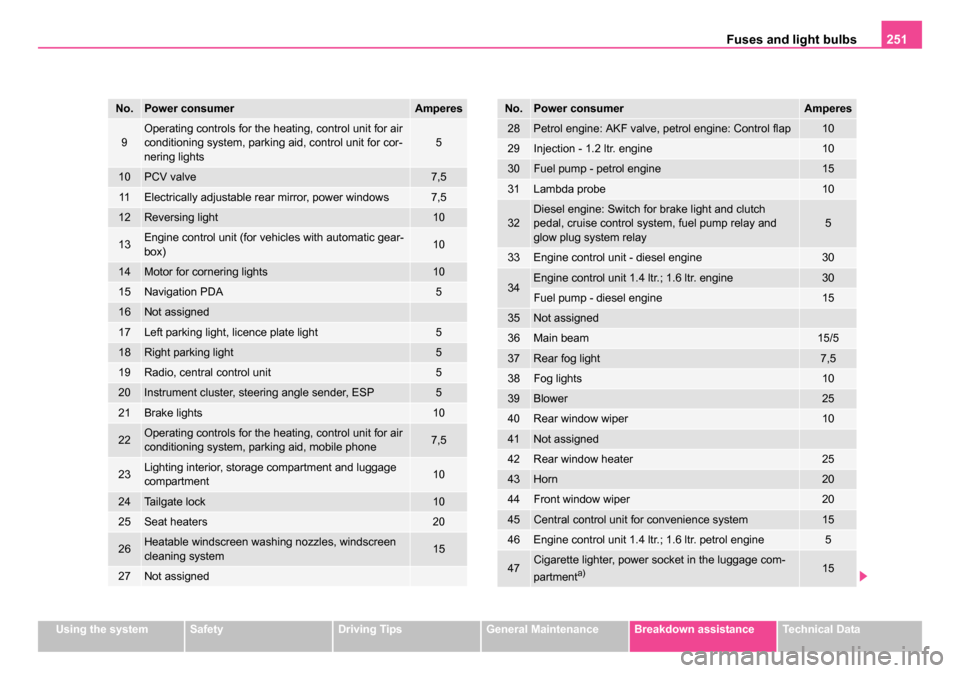
Fuses and light bulbs251
Using the systemSafetyDriving TipsGeneral MaintenanceBreakdown assistanceTechnical Data
9Operating controls for the heating, control unit for air
conditioning system, parking aid, control unit for cor-
nering lights5
10PCV valve7,5
11Electrically adjustable rear mirror, power windows7,5
12Reversing light10
13Engine control unit (for vehicles with automatic gear-
box)10
14Motor for cornering lights10
15Navigation PDA5
16Not assigned
17Left parking light, licence plate light5
18Right parking light5
19Radio, central control unit5
20Instrument cluster, steering angle sender, ESP5
21Brake lights10
22Operating controls for the heating, control unit for air
conditioning system, parking aid, mobile phone7,5
23Lighting interior, storage compartment and luggage
compartment10
24Tailgate lock10
25Seat heaters20
26Heatable windscreen washing nozzles, windscreen
cleaning system15
27Not assigned
No.Power consumerAmperes
28Petrol engine: AKF valve, petrol engine: Control flap10
29Injection - 1.2 ltr. engine10
30Fuel pump - petrol engine15
31Lambda probe10
32Diesel engine: Switch for brake light and clutch
pedal, cruise control system, fuel pump relay and
glow plug system relay5
33Engine control unit - diesel engine30
34Engine control unit 1.4 ltr.; 1.6 ltr. engine30
Fuel pump - diesel engine15
35Not assigned
36Main beam15/5
37Rear fog light7,5
38Fog lights10
39Blower25
40Rear window wiper10
41Not assigned
42Rear window heater25
43Horn20
44Front window wiper20
45Central control unit for convenience system15
46Engine control unit 1.4 ltr.; 1.6 ltr. petrol engine5
47Cigarette lighter, power socket in the luggage com-
partmenta)15
No.Power consumerAmperes
NKO 20 A05.book Page 251 Wednesday, June 21, 2006 1:42 PM
Page 254 of 274
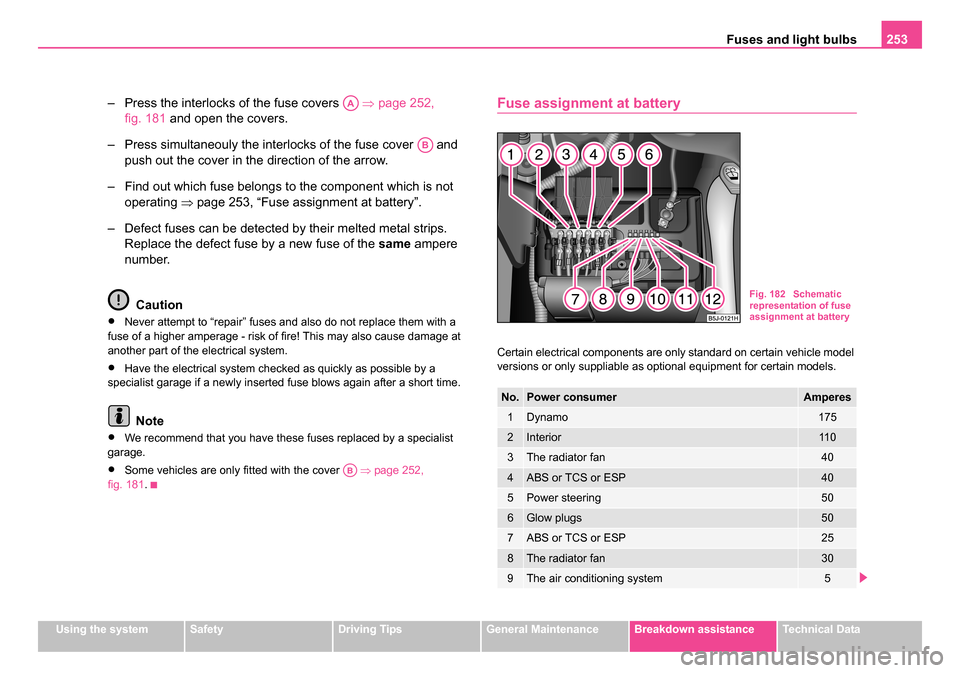
Fuses and light bulbs253
Using the systemSafetyDriving TipsGeneral MaintenanceBreakdown assistanceTechnical Data
– Press the interlocks of the fuse covers ⇒page 252,
fig. 181 and open the covers.
– Press simultaneouly the interlocks of the fuse cover and push out the cover in the direction of the arrow.
– Find out which fuse belongs to the component which is not operating ⇒page 253, “Fuse assignment at battery”.
– Defect fuses can be detected by their melted metal strips. Replace the defect fuse by a new fuse of the same ampere
number.
Caution
•Never attempt to “repair” fuses and also do not replace them with a
fuse of a higher amperage - risk of fire! This may also cause damage at
another part of the electrical system.
•Have the electrical system checked as quickly as possible by a
specialist garage if a newly inserted fuse blows again after a short time.
Note
•We recommend that you have these fuses replaced by a specialist
garage.
•Some vehicles are only fitted with the cover ⇒page 252,
fig. 181 .
Fuse assignment at battery
Certain electrical components are only standard on certain vehicle model
versions or only suppliable as optional equipment for certain models.
AA
AB
AB
No.Power consumerAmperes
1Dynamo175
2Interior11 0
3The radiator fan40
4ABS or TCS or ESP40
5Power steering50
6Glow plugs50
7ABS or TCS or ESP25
8The radiator fan30
9The air conditioning system5
Fig. 182 Schematic
representation of fuse
assignment at battery
NKO 20 A05.book Page 253 Wednesday, June 21, 2006 1:42 PM
Page 266 of 274
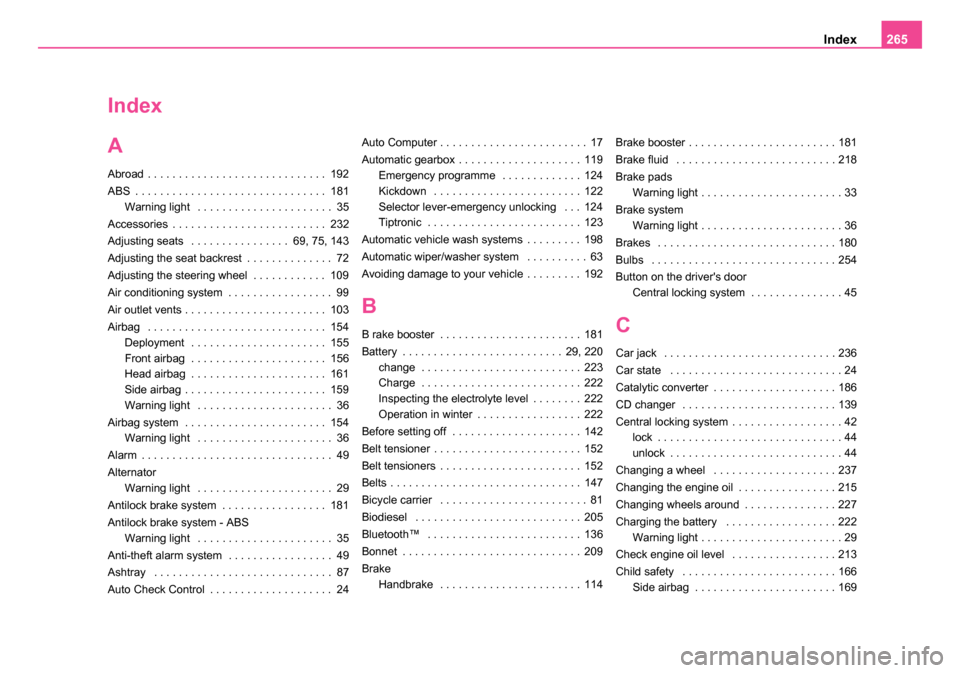
Index265
Index
A
Abroad . . . . . . . . . . . . . . . . . . . . . . . . . . . . . 192
ABS . . . . . . . . . . . . . . . . . . . . . . . . . . . . . . . 181
Warning light . . . . . . . . . . . . . . . . . . . . . . 35
Accessories . . . . . . . . . . . . . . . . . . . . . . . . . 232
Adjusting seats . . . . . . . . . . . . . . . . 69, 75, 143
Adjusting the seat backrest . . . . . . . . . . . . . . 72
Adjusting the steering wheel . . . . . . . . . . . . 109
Air conditioning system . . . . . . . . . . . . . . . . . 99
Air outlet vents . . . . . . . . . . . . . . . . . . . . . . . 103
Airbag . . . . . . . . . . . . . . . . . . . . . . . . . . . . . 154 Deployment . . . . . . . . . . . . . . . . . . . . . . 155
Front airbag . . . . . . . . . . . . . . . . . . . . . . 156
Head airbag . . . . . . . . . . . . . . . . . . . . . . 161
Side airbag . . . . . . . . . . . . . . . . . . . . . . . 159
Warning light . . . . . . . . . . . . . . . . . . . . . . 36
Airbag system . . . . . . . . . . . . . . . . . . . . . . . 154 Warning light . . . . . . . . . . . . . . . . . . . . . . 36
Alarm . . . . . . . . . . . . . . . . . . . . . . . . . . . . . . . 49
Alternator Warning light . . . . . . . . . . . . . . . . . . . . . . 29
Antilock brake system . . . . . . . . . . . . . . . . . 181
Antilock brake system - ABS Warning light . . . . . . . . . . . . . . . . . . . . . . 35
Anti-theft alarm system . . . . . . . . . . . . . . . . . 49
Ashtray . . . . . . . . . . . . . . . . . . . . . . . . . . . . . 87
Auto Check Control . . . . . . . . . . . . . . . . . . . . 24 Auto Computer . . . . . . . . . . . . . . . . . . . . . . . . 17
Automatic gearbox . . . . . . . . . . . . . . . . . . . . 119
Emergency programme . . . . . . . . . . . . . 124
Kickdown . . . . . . . . . . . . . . . . . . . . . . . . 122
Selector lever-emergency unlocking . . . 124
Tiptronic . . . . . . . . . . . . . . . . . . . . . . . . . 123
Automatic vehicle wash systems . . . . . . . . . 198
Automatic wiper/washer system . . . . . . . . . . 63
Avoiding damage to your vehicle . . . . . . . . . 192
B
B rake booster . . . . . . . . . . . . . . . . . . . . . . . 181
Battery . . . . . . . . . . . . . . . . . . . . . . . . . . 29, 220 change . . . . . . . . . . . . . . . . . . . . . . . . . . 223
Charge . . . . . . . . . . . . . . . . . . . . . . . . . . 222
Inspecting the electrolyte level . . . . . . . . 222
Operation in winter . . . . . . . . . . . . . . . . . 222
Before setting off . . . . . . . . . . . . . . . . . . . . . 142
Belt tensioner . . . . . . . . . . . . . . . . . . . . . . . . 152
Belt tensioners . . . . . . . . . . . . . . . . . . . . . . . 152
Belts . . . . . . . . . . . . . . . . . . . . . . . . . . . . . . . 147
Bicycle carrier . . . . . . . . . . . . . . . . . . . . . . . . 81
Biodiesel . . . . . . . . . . . . . . . . . . . . . . . . . . . 205
Bluetooth™ . . . . . . . . . . . . . . . . . . . . . . . . . 136
Bonnet . . . . . . . . . . . . . . . . . . . . . . . . . . . . . 209
Brake Handbrake . . . . . . . . . . . . . . . . . . . . . . . 114 Brake booster . . . . . . . . . . . . . . . . . . . . . . . . 181
Brake fluid . . . . . . . . . . . . . . . . . . . . . . . . . . 218
Brake pads
Warning light . . . . . . . . . . . . . . . . . . . . . . . 33
Brake system Warning light . . . . . . . . . . . . . . . . . . . . . . . 36
Brakes . . . . . . . . . . . . . . . . . . . . . . . . . . . . . 180
Bulbs . . . . . . . . . . . . . . . . . . . . . . . . . . . . . . 254
Button on the driver's door Central locking system . . . . . . . . . . . . . . . 45C
Car jack . . . . . . . . . . . . . . . . . . . . . . . . . . . . 236
Car state . . . . . . . . . . . . . . . . . . . . . . . . . . . . 24
Catalytic converter . . . . . . . . . . . . . . . . . . . . 186
CD changer . . . . . . . . . . . . . . . . . . . . . . . . . 139
Central locking system . . . . . . . . . . . . . . . . . . 42lock . . . . . . . . . . . . . . . . . . . . . . . . . . . . . . 44
unlock . . . . . . . . . . . . . . . . . . . . . . . . . . . . 44
Changing a wheel . . . . . . . . . . . . . . . . . . . . 237
Changing the engine oil . . . . . . . . . . . . . . . . 215
Changing wheels around . . . . . . . . . . . . . . . 227
Charging the battery . . . . . . . . . . . . . . . . . . 222 Warning light . . . . . . . . . . . . . . . . . . . . . . . 29
Check engine oil level . . . . . . . . . . . . . . . . . 213
Child safety . . . . . . . . . . . . . . . . . . . . . . . . . 166 Side airbag . . . . . . . . . . . . . . . . . . . . . . . 169
NKO 20 A05.book Page 265 Wednesday, June 21, 2006 1:42 PM